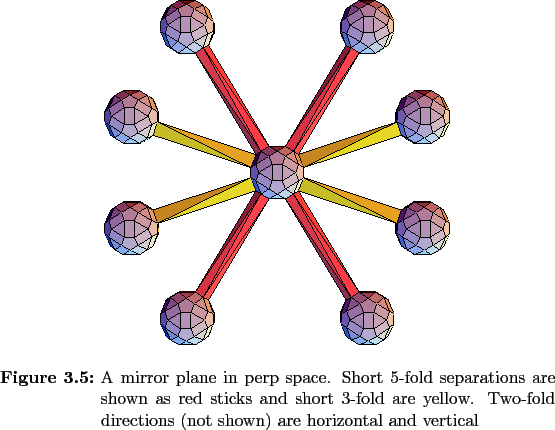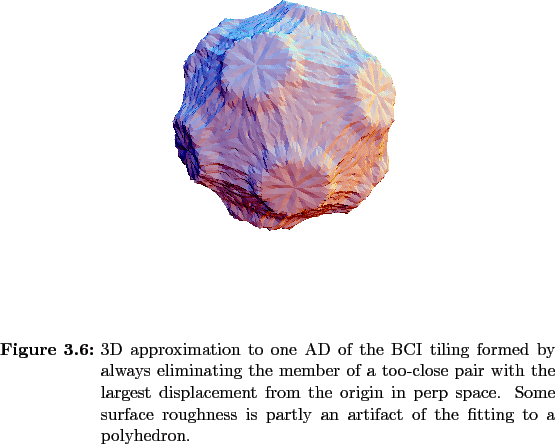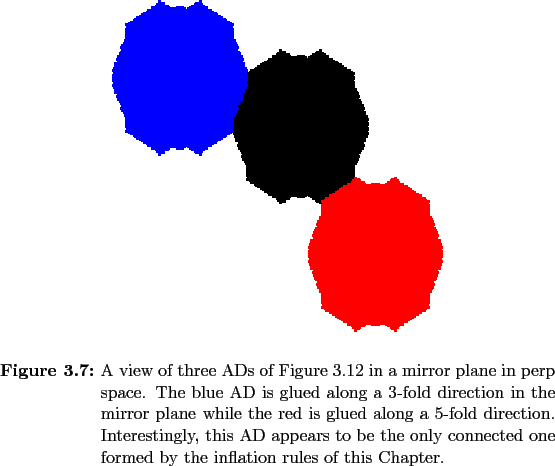Christopher J. Kimmer, Ph.D.
IU Southeast Informatics
iSci
the informatics of scientific computing
The Gluing Condition and Topology of the Acceptance Domain
That too-short distances along 3- and 5-fold directions can be
pairwise-eliminated in the tile-based construction of these tilings (and in the
vertex-based construction where the too-close separations are pruned after
each step) implies that the acceptance domains for the tilings glue along
these directions. Since little has been said about the ADs so far except
that unconstrained application of the
![]() operator leads to a fractal
acceptance domain, it is important to consider the ADs of the tilings
now. It is known that the density is invariant for each tiling constructed
by inflation rules, so the implication is that each AD has
the same volume.
operator leads to a fractal
acceptance domain, it is important to consider the ADs of the tilings
now. It is known that the density is invariant for each tiling constructed
by inflation rules, so the implication is that each AD has
the same volume.
The most efficient way to look at these ADs and gain some inkling of how they are structured is to consider mirror planes normal to two-fold axes in perp space. These are the same planes used to investigate the faceting of the critical surface in Chapter 2, and they contain two-fold axes along the vertical and horizontal directions with 5-fold and 3-fold axes as shown in Figure 3.11 . Tilings whose ADs glue along both 3-fold and 5-fold directions have not been studied very much, and their only mention in the literature has been by Katz and Gratias in Reference[ 47 ], but they give no example of such an AD.
Adjusting the density in Equation
3.17
to the form dictated
by the gluing condition in Equation
3.6
, reveals that these
tilings do not obey the gluing condition.
The SCI and BCI tilings have
N
1
and
N
2
equal to
![]() and
and
![]() while the FCI tilings
have
N
1
and
N
2
valued at
while the FCI tilings
have
N
1
and
N
2
valued at
![]() and
and
![]() ,
respectively.
,
respectively.
To put this on a better footing, it is useful to see the form of some
ADs for specific tilings. For simplicity, only ADs corresponding to BCI
tilings will be discussed since these tilings have only 1 kind of AD,
and the ADs for the BCI tilings illustrate the
behavior of the ADs of the SCI and FCI tilings. The
differences in the ADs formed by all the inflation rules
(whether BCI, FCI, or SCI) is evident in the regions of perp space
corresponding to the too-short separations of the un-pruned vertex set
![]() of Equation
3.10
. For the BCI case, there is a single
way along a 3-fold direction and a single way along a 5-fold
direction that two ADs related by a too-short separation along the
symmetry direction (3- or 5-fold) in perp space glue together. For the
SCI and FCI tilings, there is in general more than one way two ADs will
glue along these too-short separations. For the SCI tilings, the ADs
decorating integral lattice points will glue along 3-fold directions
to ADs decorating other integral lattice points, but the 5-fold gluing
will be with ADs at half-integral lattice points. The ADs at integral and
half-integral points for the SCI tilings are differentiated by
gluing along the
5-fold directions but unconstrained along the 3-fold directions.
For the FCI case, all 4 distinct ADs are constrained. For the BCI tilings,
there is only one way the ADs glue along each too-short separation.
of Equation
3.10
. For the BCI case, there is a single
way along a 3-fold direction and a single way along a 5-fold
direction that two ADs related by a too-short separation along the
symmetry direction (3- or 5-fold) in perp space glue together. For the
SCI and FCI tilings, there is in general more than one way two ADs will
glue along these too-short separations. For the SCI tilings, the ADs
decorating integral lattice points will glue along 3-fold directions
to ADs decorating other integral lattice points, but the 5-fold gluing
will be with ADs at half-integral lattice points. The ADs at integral and
half-integral points for the SCI tilings are differentiated by
gluing along the
5-fold directions but unconstrained along the 3-fold directions.
For the FCI case, all 4 distinct ADs are constrained. For the BCI tilings,
there is only one way the ADs glue along each too-short separation.
Figure
3.12
shows an approximation to the AD formed by
defining
![]() to always select the member of the too-close pair that
is in perp space closest to
x
0
. A slice of this AD in
a mirror plane is shown in
Figure
3.13
. A mirror-plane view of the AD that results
when the furthest point from
x
0
is chosen yields the AD
shown in Figure
3.14
. This AD is clearly a fractal object,
displaying some features of self-similarity.
to always select the member of the too-close pair that
is in perp space closest to
x
0
. A slice of this AD in
a mirror plane is shown in
Figure
3.13
. A mirror-plane view of the AD that results
when the furthest point from
x
0
is chosen yields the AD
shown in Figure
3.14
. This AD is clearly a fractal object,
displaying some features of self-similarity.
It is apparent from these figures that portions of the boundaries glue along both 5- and 3-fold directions and that the gluing is not one-to-one. Parts of the 3-fold gluing boundary also overlap with those of other 3-fold directions, or with the 5-fold direction.
Chris Kimmer 2011-06-01



